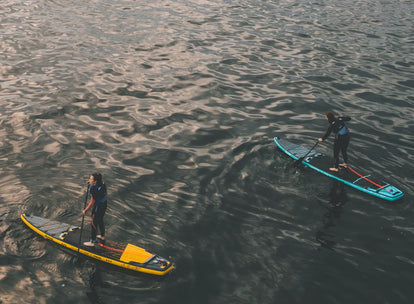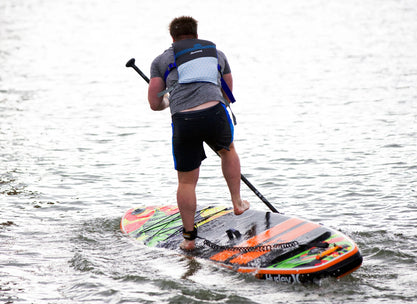Things to consider before buying a beginner's paddle board
Buying your first paddle board is super exciting, yet it can quickly become overwhelming when you begin looking at all the beginner paddle boards online and experience the vast amount of options available.
To help you decide on your first paddle board you need to consider a host of other factors to determine which board you should get. Continue reading to see the top things to consider before buying your first paddle board.
How will you use your paddle board?

As a beginner, it is likely that to start with, you want to purchase a paddle board to leisurely explore the water and therefore it is worth having a look at some all-round beginner paddle boards. However it is worth knowing that there are a wide range of activities you can undertake on a paddle board and for each of these, there are boards designed specifically. Other activities with specifically designed paddle boards include:
How much to spend?
It can be hard to decide how much to spend on your first paddle board. Focus too much on price and you may compromise on quality but focus too much on quality and you may end up spending more than your budget can afford.
When starting out it makes sense to choose a sensible budget, are you sure that you will still be interested in paddle boarding this time next year? Similarly, a lot of high end and more expensive paddle boards have lots of accessories and specialisations that you probably will not need when you are just starting out.
However it is important to remember that purchasing a really cheap paddle board may end up costing you more in the long run because of poor quality and durability. Doing your research and finding the balance between price and quality is key.
Size of your board

When choosing your first paddle board you will have to decide what size to get. As a rule of thumb, the bigger the board the more stability it will offer you, but there are other factors to consider. Stability comes from a combination of shape, width, length, volume and rider weight. Beginner boards tend to be slightly wider than other paddle boards in order to reduce roll, helping beginners to feel more stable. As a guide, 34 inches is considered ‘wide’, whereas more advanced and faster boards will have widths of 29 inches or less. Somewhere in the middle will suit most people, as the wider the board the slower it tends to be in the water, so as you progress and your balance improves, a really wide board might feel a little sluggish.
It is also important to remember to check the maximum weight capacity of the paddle board that you are interested in. A longer, thicker board will have more volume and be capable of carrying more weight, but for best performance you will need to be well below the maximum weight capacity of the board. It is best to ensure that you are significantly below the limit as extra weight will be added by a child, pet or equipment. If you exceed the maximum weight limit, the board will drag in the water or possibly even bend under your weight, making balancing, paddling and turning much more difficult. If you are unsure, use a SUP weight calculator to get an idea of the weight capacity that you need.
Storing your beginner's paddle board

When it comes to storing your paddle board, this will make the choice between an inflatable paddle board or a hard board very important. An inflatable paddle board can obviously be deflated for storage making it easier to find spare space within your home or garage.
If you choose a hard board or would prefer to keep your inflatable board inflated, then storage will be slightly trickier. You can store a paddleboard outside as long as it is not in direct sunlight and covered with tarp. However, if you would rather store your paddle board inside, building shelves or racks in a garage or utility room are a good idea. Paddle boards can also be stored against a wall although, ensure it is nose up and protect the edges touching the floor with padding or a towel.
Transporting your beginner's paddle board

Now that you have found a storage place for your paddle board you need to think about how you are going to get it from A to B, your house to the water in this instance. Owning a van or a truck makes this a lot easier, however if you do not own a large vehicle there are other solutions available.
Some cars have fixed roof racks that you can use to strap down your paddle board, but be sure that the straps you use are not over-tightened as this can cause damage to your board. If your car does not have fixed roof racks you can purchase rack systems to attach to the roof of your car yourself. Some can be made to fit your car and will be more secure than others, it is also possible to lock your board to the rack preventing it from being stolen.
Buying your first paddle board is really exciting yet there is much to take into consideration, make sure you do your research before making a purchase and speak to an expert if you are unsure.


